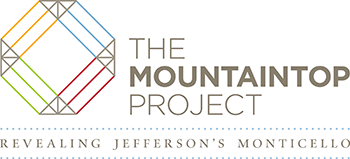Landscape History from a Utility Trench (Part 1)

Since November, Monticello’s archaeology team has been battling record cold and snow. We have excavated a 140-foot long trench running from the smokehouse in the South Dependency, across the Kitchen Yard and down to the vegetable garden terrace (Figure 1). The trench will contain pipes serving the new geo-thermally powered HVAC system, along with a host of other utilities.

Excavation of the trench offered a unique opportunity to advance our understanding of the dynamic mountaintop landscape. We are discovering how Thomas Jefferson’s design intentions, the labor of enslaved workers, and a variety of geological processes shaped the mountain’s contours.
Understanding what we have found requires thinking about what we would have found three hundred years ago, decades before Jefferson began building the first Monticello in 1770.
First, we would have dug through a several-foot thick zone of topsoil. This is what soil geeks call the “A horizon,” a fluffy loam, rich in organics from millennia of leaf decomposition on the forest floor. Below that we would encounter subsoil, or a “B horizon,” rich in clay but free of organic material. Further down we’d find a “C horizon,” sticky clay derived from the chemical weathering of the parent rock of Monticello Mountain. Scattered throughout the clay would be decomposing greenstone boulders and cobbles. The A, B, and C horizons comprise a natural soil profile that is the result of millennia of weathering on the mountaintop.
What have we actually found? Let’s start in the Kitchen Yard. There we encountered six to eight inches of sticky clay, enriched with organic matter. The clay contains a mix of domestic artifacts including thousands of ceramics and glass sherds with manufacturing dates spanning the entire nineteenth century (Figure 2). The sticky clay sits on top of another clay-rich layer that is relatively free of organic matter and devoid of artifacts. We think this lower layer is the original subsoil, or B horizon. What’s missing is any trace of the A horizon that originally sat above it. Apparently the A horizon eroded away before the upper sticky clay layer was deposited.

But where did the sticky clay come from? We hypothesize that the C horizon was exposed to the elements around 1800. That’s when Jefferson’s slaves made a 10-foot deep cut into the side of the mountain to construct the South Dependencies. Subsequent erosion moved the clay sediment downslope across the Kitchen Yard. Over the ensuing decades, Jefferson’s enslaved domestic servants and, later, members of the Levy household, discarded trash, enriching the clay with organic material and depositing nineteenth-century artifacts. We still need to catalog the artifacts and analyze them quantitatively, but it appears that toward the end of the nineteenth century the surface was plowed, vertically mixing trash from the Jefferson and Levy periods.
There’s a final puzzle. Eighteenth-century artifacts appear to be rare in the Kitchen Yard squares. These artifacts would have been discarded on the original topsoil as it eroded away. One possibility is that the artifacts eroded with the sediment. Rainfall on this gentle slope generates enough force to move the particles of dirt that comprised the A horizon, but not pebble and cobble-sized ceramic fragments. These sherds would have been left behind as “lag” deposits – a phenomenon we have encountered in our work at outlying slave quarter sites on eroded slopes about a half mile east of the House(e.g. Site 6). This implies that during the late-eighteenth century, trash was being discarded elsewhere. That makes sense, since the South Dependency, with its domestic spaces and new kitchen had not yet been built. From 1770 to 1809 the kitchen was housed in the basement of the South Pavilion, roughly 100 feet to the west.
Let me close with a caveat. The foregoing account is preliminary; it’s a hypothesis. It needs to be evaluated and extended using quantitative evidence that will only be available after months of washing, labeling, and cataloging into the DAACS database the thousands of artifacts we have recovered. As our excavation nears an end, the analytical work is just beginning.
In future posts I’ll share more discoveries from our trench. They include a cobble surface stretching across Mulberry Row, a mysterious alignment of cobble and boulders on the vegetable garden terrace, and a brick pavement adjacent to the Weaver’s Cottage. Stay tuned!
The Mountaintop Project is made possible by a transformational contribution from David M. Rubenstein. Leading support was provided by Fritz and Claudine Kundrun, along with generous gifts and grants from the Sarah and Ross Perot, Jr. Foundation, the Robert H. Smith Family Foundation, Mr. and Mrs. John H. Birdsall, Mr. and Mrs. B. Grady Durham, the Mars Family, the Richard S. Reynolds Foundation, the National Endowment for the Humanities, Charlotte Moss and Barry Friedberg, the Joseph and Robert Cornell Memorial Foundation, the Mary Morton Parsons Foundation, the Cabell Foundation, the Garden Club of Virginia, and additional individuals, organizations, and foundations.


